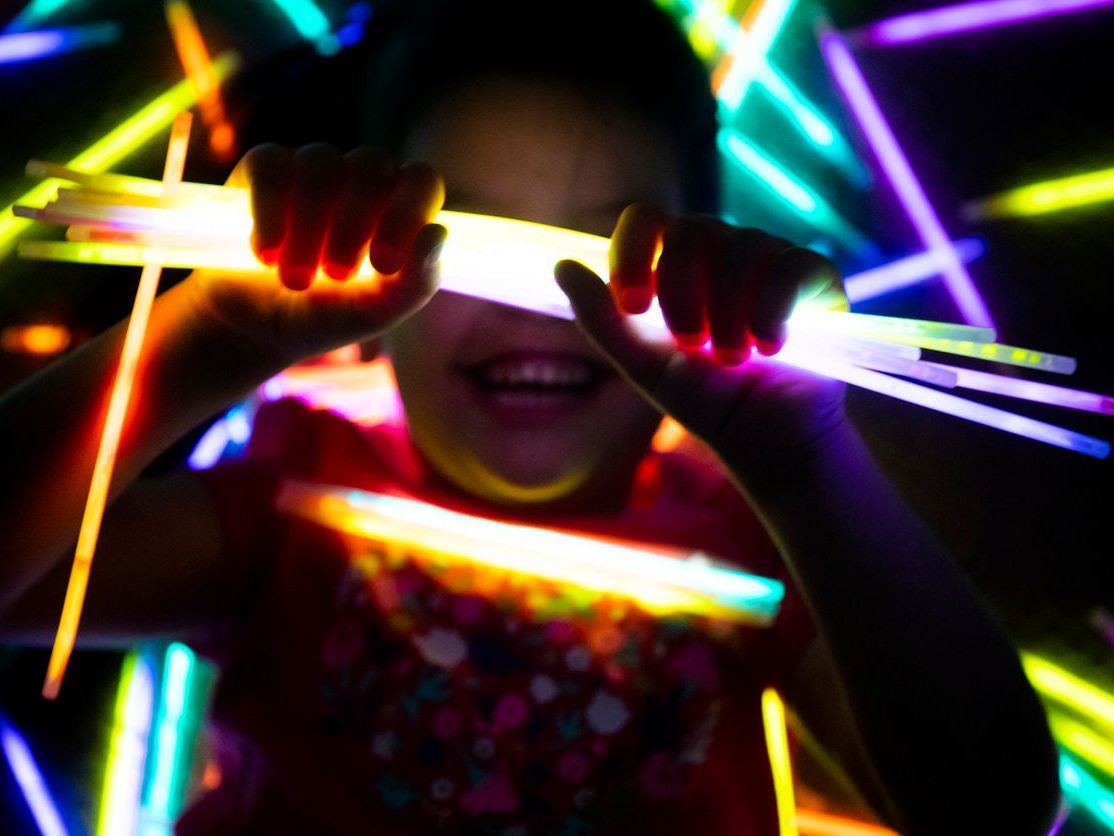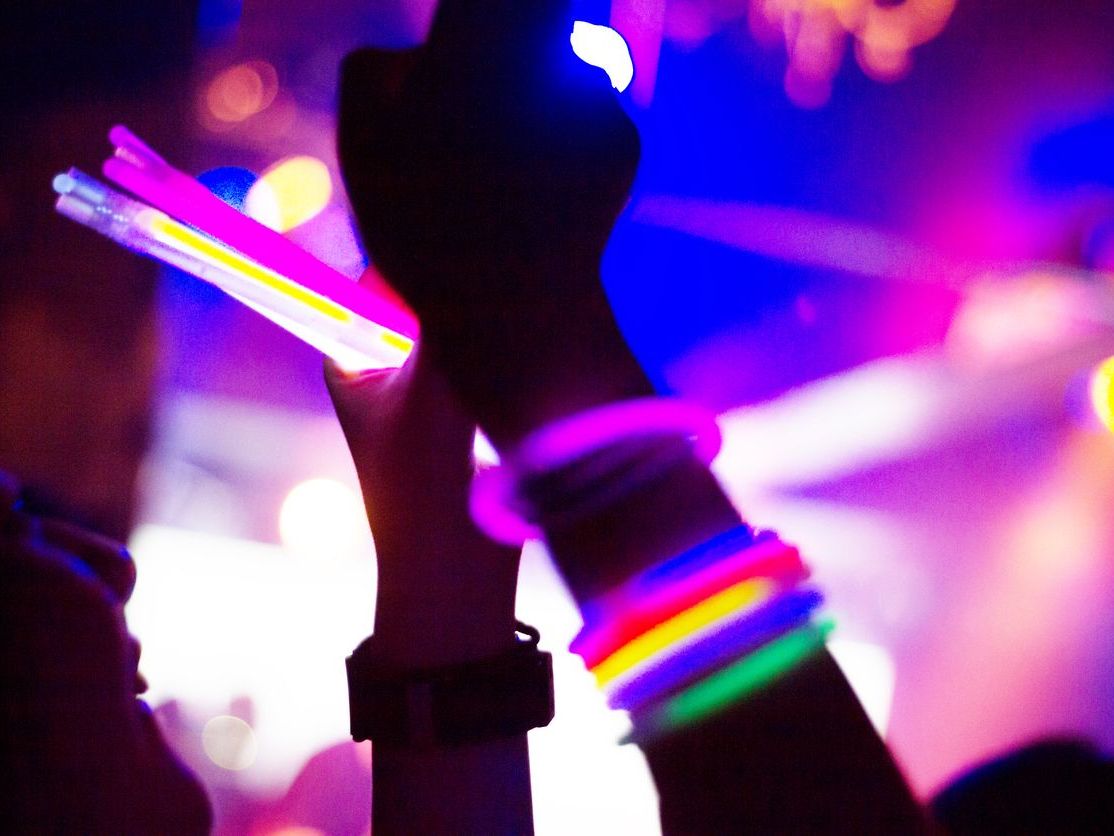Are Glow Sticks Dangerous?

The Bottom Line
A glow stick is a plastic tube containing two reactive chemicals, which combine when the tube is bent, resulting in a luminescent glow. Glow sticks are not poisonous. If swallowed, mouth irritation and an upset stomach may occur. The liquid can also cause skin and eye irritation. If the glow stick breaks and the liquid leaks into your mouth, eyes, or skin, rinse with water.

What is in glow sticks? How do glow sticks work?
A glow stick is a plastic tube containing 2 reactive chemicals: hydrogen peroxide and either diphenyl oxalate (i.e., cyalume) or a phthalate (i.e., dibutyl or dimethyl phthalate). The hydrogen peroxide is contained in a glass vial, which separates it from diphenyl oxalate or phthalate, a dye and sodium salicylate, in the plastic tube. The fluorescent dye supplies the color to the glow stick, while the sodium salicylate speeds up the reaction between the chemicals. When the tube is bent, the chemicals combine, resulting in a luminescent glow. This chemical reaction is called chemiluminescence.Are glow sticks radioactive?
No. Glow sticks are not radioactive.Are glow sticks poisonous? What happens if a glow stick breaks in your mouth?
Glow sticks are not poisonous and are considered non-toxic. If the glow stick breaks in your mouth, it may cause mouth irritation and tastes awful. Wipe your mouth with a wet cloth and drink water. Swallowing the liquid may result in an upset stomach.What are glow sticks used for?
Glow sticks are usually used at night, especially at parties, concerts, and celebrations. They are especially popular around Halloween. They are available as sticks, toys, jewelry such as necklaces and bracelets, and other gimmicky items. Other uses for glow sticks include as a light source for camping, diving, and emergency services.Do glow sticks have glass in them?
Yes. One of the chemicals, hydrogen peroxide, is contained inside a glass vial. When you bend the glow stick you break the glass vial. This is what allows the chemicals to combine. The breaking vial is responsible for the “cracking” noise you hear when you bend the glow stick to activate it.What should I do if I get glow stick liquid in my eye or on my skin?
The liquid in the glow stick can be irritating and cause a burning sensation to the eyes and skin. It can cause your eyes to tear up and sting. If it gets in someone’s eye, immediately rinse the eye with running water for 15 minutes. If it gets on the skin, wash with soap and water.If someone swallows glow stick liquid, gets it in the eyes or on the skin, or if you have a question about using glow sticks safely, help from experts is available through the webPOISONCONTROL online tool and by phone at 1-800-222-1222. Poison Control’s expert guidance is always free, confidential, and available 24 hours a day.
Wendy Klein-Schwartz, Pharm.D., MPH
Clinical Toxicologist
Poison Control Media Information
Did you find this page helpful? If so, we need your support. Poison Control is in constant competition with misinformation online. Links to www.poison.org or our webPOISONCONTROL triage tool from other websites and blogs help internet searchers quickly find accurate information and Poison Control’s contact information in an emergency. If you use the content from this page, please provide attribution via a link back to this page, www.poison.org, or https://triage.webpoisoncontrol.org/#!/exclusions. By doing so, you could save a life. Thank you!
Poisoned?
Call 1-800-222-1222 or
Prevention Tips
- Use glow sticks as intended by the manufacturer.
- Keep glow sticks and glow jewelry out of the mouth.
- Keep glow sticks out of reach of pets.
- Do not cut open glow sticks.
- Supervise children if they are playing with glow sticks.
- Check glow stick for cracks. If a glow stick is cracked, breaks open, or is leaking, discard it in the trash.
This Really Happened
At a party, a 16-year-old girl thought it would look cool if her lips and tongue glowed, so she intentionally bit into a glow stick. She immediately experienced a burning sensation in her mouth. She spit the liquid out and rinsed her mouth with bottled water. Still concerned that she had ‘poisoned’ herself, she sought advice from the poison center. She was reassured that rinsing her mouth was the only treatment needed and that she should be fine.References
Poisoned?
Call 1-800-222-1222 or
Prevention Tips
- Use glow sticks as intended by the manufacturer.
- Keep glow sticks and glow jewelry out of the mouth.
- Keep glow sticks out of reach of pets.
- Do not cut open glow sticks.
- Supervise children if they are playing with glow sticks.
- Check glow stick for cracks. If a glow stick is cracked, breaks open, or is leaking, discard it in the trash.
